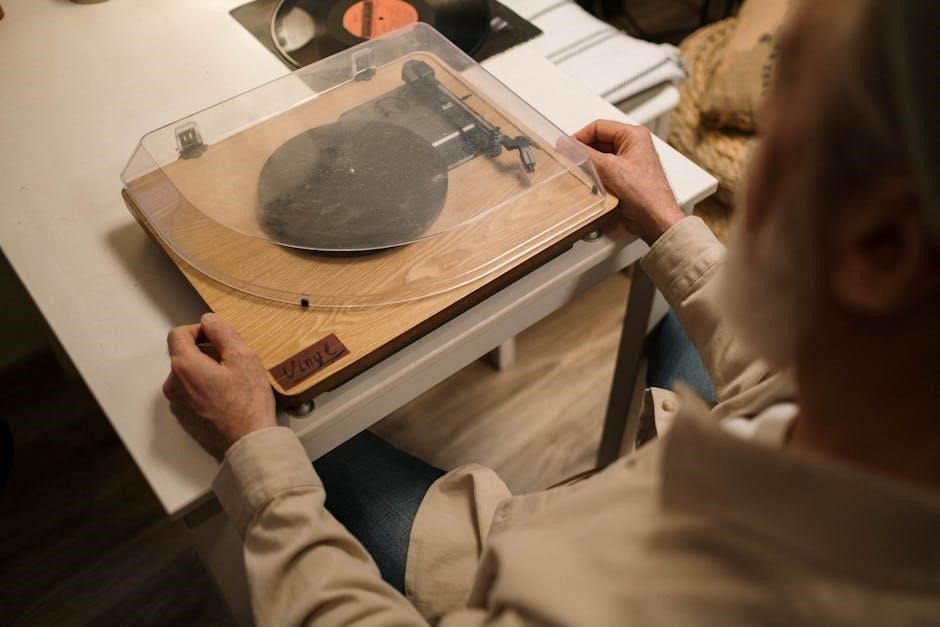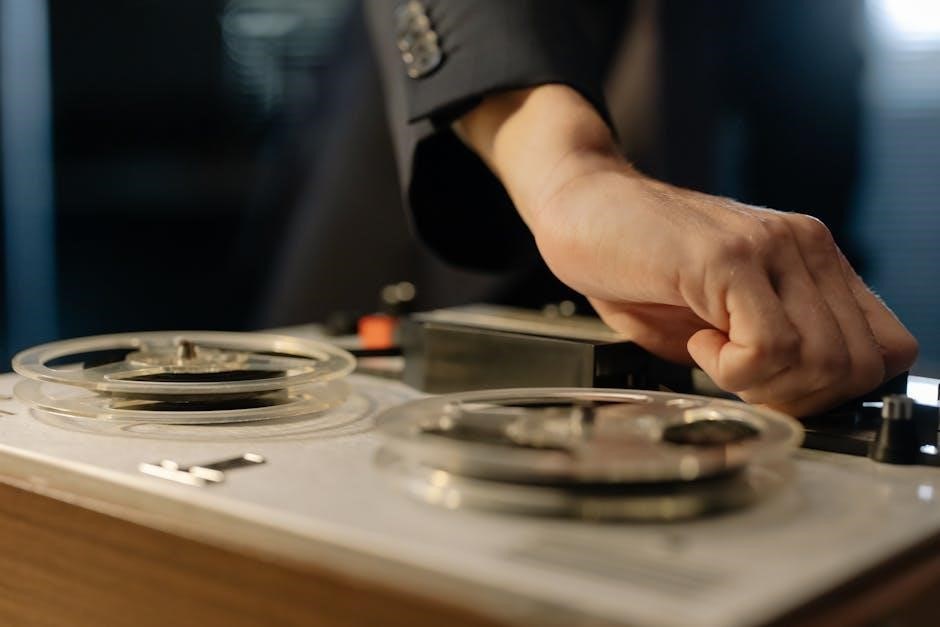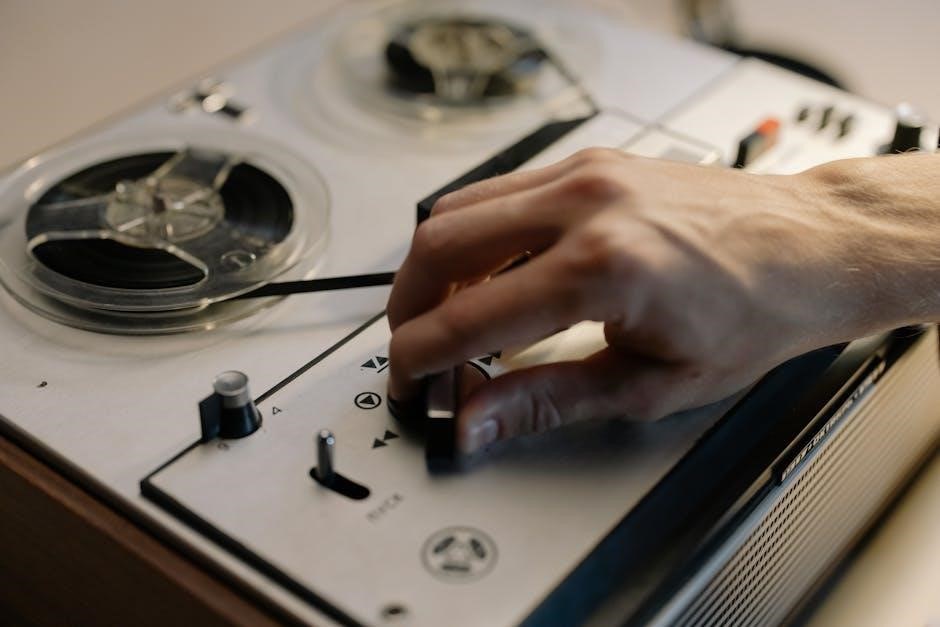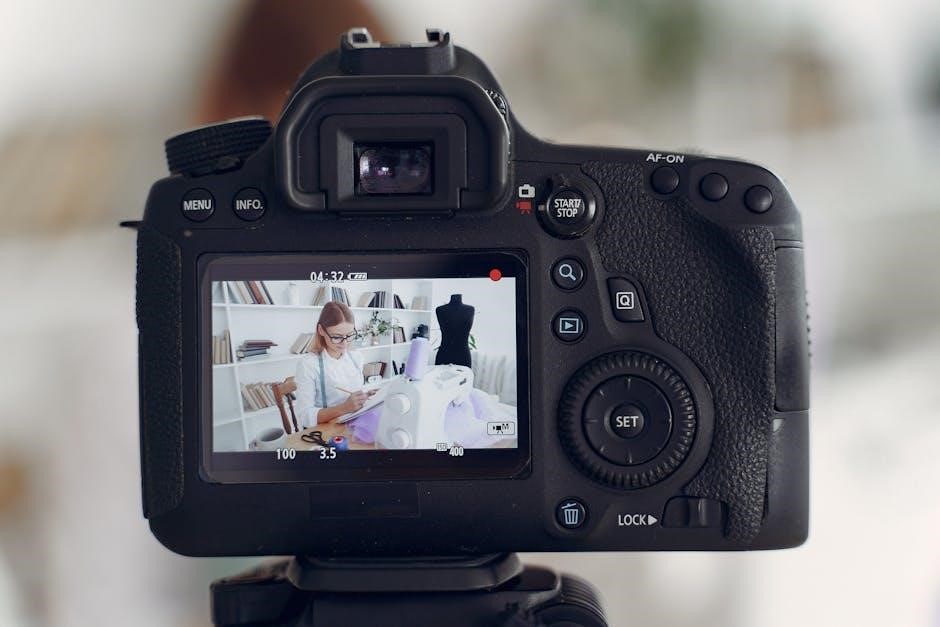The Bravo Reflux Recorder is a wireless device used to monitor gastroesophageal reflux disease (GERD). It works with a pH capsule to track acid reflux episodes, providing detailed data for accurate diagnosis and treatment planning. This user-friendly tool helps patients and clinicians understand reflux patterns, enabling effective management of symptoms and personalized care strategies.
1.1 Purpose of the Bravo Reflux Recorder
The Bravo Reflux Recorder is designed to assess gastroesophageal reflux disease (GERD) by measuring acid reflux episodes in the esophagus. Its primary purpose is to provide detailed data on the frequency, duration, and severity of acid reflux events. The device captures information over 48 to 96 hours, offering insights into reflux patterns and symptom correlation. This data helps clinicians diagnose GERD accurately and develop personalized treatment plans. By monitoring reflux activity, the recorder aids in understanding triggers and evaluating the effectiveness of therapies, ultimately improving patient outcomes and quality of life.
1.2 Overview of Gastroesophageal Reflux Disease (GERD)
Gastroesophageal reflux disease (GERD) is a chronic condition where stomach acid flows back into the esophagus, causing discomfort. It occurs when the lower esophageal sphincter (LES) fails to close properly, allowing acid to rise. Common symptoms include heartburn, regurgitation, chest pain, and, in some cases, coughing or hoarseness. GERD can be triggered by factors like obesity, certain diets, or eating habits. Untreated, it may lead to complications such as esophagitis or narrowing of the esophagus. Accurate diagnosis and monitoring are essential to manage symptoms effectively and prevent long-term damage.
1.3 Importance of Accurate Monitoring
Accurate monitoring of acid reflux is crucial for diagnosing and managing GERD effectively. It provides detailed insights into the frequency, severity, and patterns of reflux episodes, helping identify triggers and assess treatment effectiveness. Precise data enables healthcare providers to tailor personalized care plans, including medication adjustments, lifestyle modifications, or further interventions. Without accurate monitoring, symptoms may be misdiagnosed or undertreated, potentially leading to complications. The Bravo Reflux Recorder ensures reliable data collection, empowering both patients and clinicians to make informed decisions and achieve better outcomes in managing GERD.

Components of the Bravo Reflux System
The Bravo Reflux System includes a Bravo pH Capsule, a Reflux Recorder, and a Patient Diary. These components work together to measure and track acid reflux activity effectively.
2.1 Bravo pH Capsule
The Bravo pH Capsule is a small, wireless device placed in the esophagus during an endoscopic procedure. It measures acidity levels and transmits data to the Reflux Recorder. The capsule is calibration-free, ensuring accurate and continuous monitoring of acid reflux episodes for up to 48 hours. Its compact design minimizes discomfort, allowing patients to go about their daily activities during the testing period. The capsule collects essential data on reflux frequency, duration, and severity, which is later analyzed to guide personalized treatment plans for GERD management.
2.2 Bravo Reflux Recorder
The Bravo Reflux Recorder is a small, portable device that captures data transmitted from the Bravo pH Capsule. Worn on a belt or waistband, it continuously records acid reflux episodes for up to 48 hours. The recorder features buttons for marking symptoms like heartburn and meal times, helping correlate reflux episodes with daily activities. Its user-friendly design ensures minimal disruption to daily life, while the collected data provides detailed insights for accurate GERD diagnosis and treatment planning. The recorder is essential for gathering comprehensive information on reflux patterns, aiding healthcare providers in developing personalized care strategies.
2.3 Patient Diary
The Patient Diary is an essential companion to the Bravo Reflux Recorder, allowing patients to document symptoms, meal times, and activities during the monitoring period. It provides context to the data recorded by the Bravo Reflux Recorder, helping healthcare providers understand the relationship between symptoms and reflux episodes. Patients are encouraged to note when symptoms like heartburn or regurgitation occur, as well as the timing of meals, sleep positions, and any medications taken. Detailed entries in the diary enhance the accuracy of the test results, aiding in the diagnosis and personalized treatment of GERD. Consistent and thorough documentation is key to maximizing the benefits of the test.

Preparation for the Bravo Reflux Test
Preparation involves following specific pre-test instructions, such as fasting and avoiding certain medications. Patients must adhere to dietary restrictions and complete any required fasting before the procedure begins.

3.1 Pre-Test Instructions
Before undergoing the Bravo Reflux Test, patients must follow specific pre-test instructions to ensure accurate results. This includes fasting for a specified period, typically 24 hours, and avoiding certain medications unless directed by a physician. Dietary restrictions, such as avoiding caffeine, alcohol, and acidic foods, may also be recommended; Patients should inform their doctor of any allergies or medical conditions and avoid eating or drinking anything on the day of the procedure. Additionally, smoking and chewing gum should be avoided as they can stimulate acid production. Adhering to these guidelines is crucial for the success of the test.
3.2 Placement of the Bravo pH Capsule
The Bravo pH Capsule is placed in the esophagus during an endoscopic procedure. A small, flexible tube guides the capsule to the desired location, where it attaches to the esophageal wall using small prongs. This minimally invasive process typically takes a few minutes and is performed on an outpatient basis. Patients may experience mild discomfort during the procedure but usually resume normal activities shortly after. Once in place, the capsule begins monitoring acid levels immediately, providing continuous data for up to 48 hours. The procedure carries a small risk of complications, such as bleeding or perforation, though these are rare.
3.4 Setting Up the Bravo Reflux Recorder
To set up the Bravo Reflux Recorder, attach it to your belt or waistband using the provided clip. Turn on the device by pressing the power button until the blue light flashes, indicating it is ready to receive data. Ensure the recorder is within 3 feet of the pH capsule to maintain a strong signal. Once activated, the recorder will automatically begin capturing data from the capsule. Familiarize yourself with the buttons for marking symptoms, meals, and sleep positions. Press any symptom button to confirm the device is functioning correctly. Follow your doctor’s instructions for any additional setup steps to ensure accurate data collection.

Using the Bravo Reflux Recorder
Turn on the recorder and wear it on your belt. Press buttons to mark symptoms, meals, and sleep positions, ensuring accurate correlation of symptoms with reflux data.
4.1 Turning On the Recorder
To turn on the Bravo Reflux Recorder, press any button to activate the backlight. Ensure the device is within 3 feet of the pH capsule for proper signal reception. The recorder will automatically begin capturing data once powered on. A flashing blue light indicates successful activation. If the recorder does not turn on, press and hold the button for 5 seconds to reset. Proper initialization ensures accurate data collection for your GERD assessment.
4.2 Recording Symptoms
Press any button on the Bravo Reflux Recorder to activate the backlight. Use the symptom buttons to record heartburn, regurgitation, or chest pain. Ensure the backlight is on before pressing buttons. Document the time displayed on the recorder in your patient diary. Press the corresponding symptom button once to mark the event. The recorder captures the onset and duration of symptoms, aiding in accurate data correlation. This process helps link symptoms to reflux episodes, providing valuable insights for diagnosis and treatment planning. Consistent recording ensures comprehensive data collection for your GERD assessment.
4.3 Marking Meal Times
Press the Meal button on the Bravo Reflux Recorder when starting and ending meals to accurately track eating periods. This helps correlate reflux episodes with meal times. Include all meals and snacks, noting the time and food type in your diary. The recorder captures meal durations, aiding in identifying triggers. Consistent recording ensures precise data for analyzing reflux patterns and tailoring treatment plans. Accurate meal tracking enhances diagnostic accuracy, helping healthcare providers understand your reflux triggers and develop personalized strategies for managing GERD effectively.
4.4 Documenting Sleep Positions
Press the Bed button on the Bravo Reflux Recorder when lying down at a 45-degree angle or lower to document sleep positions. This helps track reflux episodes during rest. Note the time in your diary and press the button again when changing positions or waking up. Consistent documentation helps correlate sleep patterns with reflux activity. Accurate recording of supine periods aids in identifying how sleep positions may trigger symptoms. This data is crucial for tailoring treatment plans to manage GERD effectively and improve overall comfort during rest.

Data Collection and Interpretation
The Bravo Reflux Recorder captures comprehensive reflux data, worn for 48 hours, providing insights into acid exposure, symptom patterns, and triggers for accurate diagnosis and treatment planning.
5.1 Understanding pH Levels
The Bravo Reflux Recorder measures esophageal pH levels to assess acid reflux severity. Normal pH levels typically range above 4, while values below 4 indicate acid exposure. The recorder captures continuous data, correlating pH drops with symptoms like heartburn or regurgitation. This information helps determine reflux frequency, duration, and correlation with meals or sleep positions. Accurate pH monitoring is crucial for diagnosing GERD and guiding treatment. The data is analyzed to identify patterns, such as acidic spikes, aiding in personalized treatment plans. Understanding pH levels is essential for interpreting test results and managing GERD effectively. This data is key to precise diagnosis and therapy.
5.2 Analyzing Reflux Episodes
The Bravo Reflux Recorder captures detailed data on acid reflux episodes, including frequency, duration, and severity. The device records each reflux event, allowing clinicians to identify patterns, such as peak times or triggers. By analyzing the data, healthcare providers can assess the correlation between acid exposure and symptoms like heartburn or chest pain. This information helps determine the severity of GERD and guides personalized treatment plans. The recorder’s data also reveals trends, such as increased reflux during meals or sleep, aiding in targeted interventions. Accurate analysis of reflux episodes is crucial for effective GERD management and improving patient outcomes.
5.3 Correlating Symptoms with Data
The Bravo Reflux Recorder enables precise correlation of symptoms with reflux episodes by syncing data from the pH capsule with patient-reported symptoms. Patients mark symptoms like heartburn or chest pain using buttons on the recorder, creating a timestamped log. This data, combined with pH readings, helps clinicians identify patterns and triggers. For example, symptoms occurring after meals or during sleep can be linked to specific reflux episodes. Accurate correlation is essential for diagnosing GERD severity and tailoring treatments. The recorder’s data, along with the patient diary, provides a comprehensive view, ensuring personalized and effective management of acid reflux symptoms.

Troubleshooting Common Issues
If the recorder beeps, check proximity to the capsule and reset by holding it to your chest. For signal loss, ensure proper capsule placement. Low battery? Charge promptly to avoid data gaps.
6.1 Recorder Not Turning On
If the Bravo Reflux Recorder fails to turn on, first ensure the battery is charged. Connect it to the provided charger and wait a few minutes. If it still doesn’t power up, check for any visible damage or loose connections. Reset the device by pressing and holding the power button for 10 seconds. If issues persist, contact your healthcare provider for assistance. Always refer to the manual for specific troubleshooting steps to resolve the problem effectively.
6.2 Loss of Signal

If the Bravo Reflux Recorder loses signal, ensure the capsule and recorder are within range (typically 3 feet). Move away from electronic devices that may interfere. If the recorder beeps, check the connection and proximity. Reset by holding the recorder to your chest for 10 seconds. If the issue persists, contact your healthcare provider for assistance. Signal loss may affect data accuracy, so prompt resolution is crucial for reliable test results. Always follow the troubleshooting steps outlined in the manual to restore connectivity and ensure uninterrupted monitoring.

6.3 Battery Life Concerns
The Bravo Reflux Recorder is designed to last the duration of the test, typically 48 hours. If battery life concerns arise, ensure the recorder is not left on unnecessarily. Avoid excessive button presses, as this can drain power. If the recorder beeps or the blue light flashes erratically, it may indicate low battery. Contact your healthcare provider if issues persist. Proper handling and storage can help preserve battery life. Always follow the manual’s guidelines for usage and power management to ensure uninterrupted data collection during the test period.

Frequently Asked Questions
Patients often ask about medication use, test duration, and discomfort. The recorder is typically worn for 48 hours, and most medications can be continued. Discomfort is rare but should be reported to your doctor. Proper use ensures accurate results, aiding in effective GERD management. Always refer to the manual or consult your healthcare provider for clarification on any concerns during the testing period.
7.1 Can I Continue My Medication?
Generally, you can continue your medication during the Bravo Reflux Test, but inform your doctor about all medications, including antacids or acid reducers. Some medications may need to be adjusted to ensure accurate test results. Always follow your physician’s specific instructions regarding medication use during the test period. It’s important to document any medication taken in your patient diary, as this information helps correlate symptoms and reflux episodes. Your doctor will use this data to tailor a personalized treatment plan, ensuring the best possible management of your GERD symptoms.
7.2 How Long Do I Need to Wear the Recorder?
The Bravo Reflux Recorder is typically worn for 48 hours to capture comprehensive data on acid reflux patterns. In some cases, your doctor may extend the monitoring period if additional information is needed. The recorder is small and convenient, worn on your belt or waistband, allowing you to go about your daily activities without disruption. During this time, it will continuously collect data on acid reflux episodes, symptoms, and meal times. Your doctor will analyze this information to assess the severity of your GERD and develop an effective treatment plan tailored to your needs;
7.3 What If I Experience Discomfort?
If you experience discomfort during the Bravo Reflux test, it is usually mild and temporary. However, if the discomfort persists or worsens, inform your doctor immediately. You can press the symptom button on the recorder to log the event and note the time in your diary. This helps correlate any discomfort with reflux activity. Do not remove the recorder or capsule yourself. Your healthcare provider will assess the situation and provide appropriate guidance. It is essential to follow their instructions to ensure accurate test results and your comfort throughout the monitoring period.
The Bravo Reflux Recorder is a valuable tool for diagnosing GERD, offering accurate data and enhancing treatment planning. Patient cooperation ensures optimal results and improved outcomes.
8.1 Importance of Adhering to Instructions
Adhering to the Bravo Reflux Recorder instructions ensures accurate data collection and reliable test results. Proper use of the device, including symptom recording and meal tracking, is crucial for diagnosing GERD effectively. Failure to follow guidelines may lead to incomplete or inaccurate data, which could delay diagnosis or treatment. Patients should avoid medications that may interfere with results unless instructed otherwise. By carefully following the manual, patients contribute to precise insights into their reflux patterns, enabling healthcare providers to develop tailored treatment plans. Consistent adherence improves the overall effectiveness of the test and supports better management of GERD symptoms.
8.2 Benefits of Accurate Data Collection
Accurate data collection with the Bravo Reflux Recorder provides precise insights into reflux patterns, enabling healthcare providers to make informed treatment decisions. By capturing detailed information on acid reflux episodes, symptom correlations, and lifestyle factors, the device helps identify triggers and severity. This data supports personalized treatment plans, reducing trial-and-error approaches. Patients benefit from targeted therapies, while clinicians gain a clearer understanding of GERD progression. Reliable data also enhances monitoring of treatment effectiveness, ensuring adjustments are based on real evidence. Ultimately, accurate data collection improves patient outcomes and streamlines GERD management, making it a cornerstone of effective care.